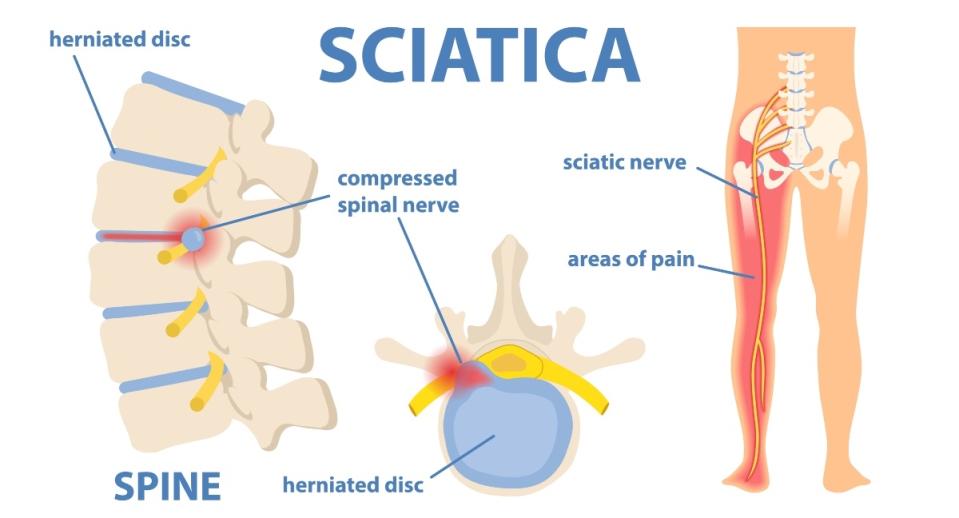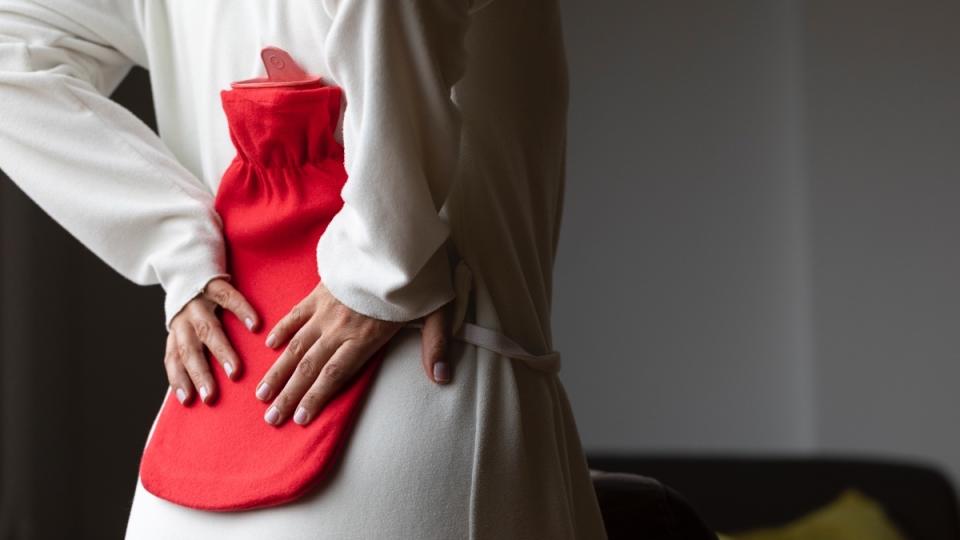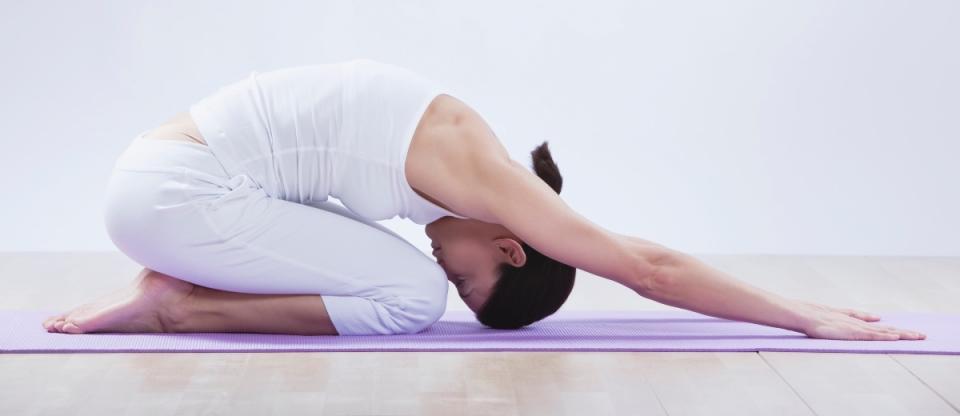Heat or Ice for Sciatica? Experts Say Both in *This* Order — And Share More Home Cures To Speed Healing
When stubborn sciatica pain flares, it can quite literally be a pain in the butt. The sharp, shooting sensation that runs from your lower back down your leg can make it difficult to do even simple activities like walking the dog or bending over to pick up a bag of groceries. So it's natural to want effective relief fast. But if you've heard that using heat or ice for sciatica can help, you're probably wondering which one is your best bet (hint: it's both!). Here's what the physicians have to say, plus more easy home tips to stop sciatica pain in a hurry.
Understanding what causes sciatica pain
Sciatica happens when one or more of the nerves (including the sciatic nerve) that runs down your lower back and legs becomes compressed or irritated. Age-related spine changes, like a herniated disk or bone spurs, are the most common culprit. But nerve compression can also come from an injury or arthritis. And the problem is more common than you might think: up to 40% of people will experience sciatica at some point. (Not sure if you have sciatica? Click through to our sister publication to learn if your paint is caused by pseudo sciatica instead — and find out how to treat it.)

The result of this nerve compression is a burning or shock-like pain that runs down the leg, as well as tingling or numbness. In severe cases, sciatica can also cause muscle weakness or a loss of bowel or bladder control. The good news is that most cases of sciatica aren't severe. "Most if not all cases can be managed at home," assures Nicholas Beatty, DO, RMSL, a physiatrist at the Hospital for Special Surgery in New York City.
That's especially welcome news, considering research in American Family Physicians found more invasive treatment options like steroid injections into your spine are no better than a placebo when it comes to easing sciatica pain. What's more, surgery to alleviate sciatica can be costly, and the pain can return in as little as a year. Luckily, applying ice and heat to your back are two of the most easy, effective ways to start healing sciatica pain.
When to use ice and heat for sciatica
Turns out, you don't have —and actually shouldn't — use just one or the other. You'll get the most relief from sciatica pain by using ice and heat on your lower back, according to a clinical trial published in the Journal of Clinical & Diagnostic Research. The key is applying each one at the right time.
1. Use ice first for sciatica
When sciatica pain first flares up, you'll want to start by using ice for a few days. Ice works as a temporary numbing agent that can reduce discomfort when your pain first arises. "Typically, ice is used as an analgesic or pain reliever. It blocks superficial pain fibers and alters the experience of pain," explains Dr. Beatty, dulling the ache.
Dr. Beatty suggests using ice for the first 48 to 72 hours of a sciatica flare to decrease nerve pain signaling, which should ease the ache. Simply wrap an ice pack or a bag of frozen vegetables in a cloth or towel to prevent the ice from directly touching your skin, which could cause frostbite. Then lie down and apply the ice pack to your lower back two to three times a day for 20 to 30 minutes at a time, he recommends.
2. Then switch to heat for sciatica
After 72 or so, once the worst pain has subsided, bringing on the heat can help relieve stiffness by encouraging your lower back muscles to relax. "It brings new blood flow to the muscles to address residual tightness that's common with sciatica," Dr. Beatty says. And research in Frontiers in Synaptic Neuroscience found heat also reduces pain signaling from the sciatic nerve to the brain and tamps down inflammation. (Click through to our sister publication to see how onion peel tea curbs inflammation, too.)
To reduce the risk of burns, the heating pad or hot water bottle should be warm but not hot to the touch. And again, wrap it in a cloth or towel so it's not in direct contact with your skin. Then lie down and place the heating pad on your back for 20 to 30 minutes, two to three times daily, Dr. Beatty says. You can use heat for as many days as needed to reduce muscle tightness.

6 more ways to soothe sciatica pain
Heat and ice aren't the only sciatica soothers. In fact, using a few different pain-relieving techniques at the same time will put you on the fast track to feeling better, notes Dr. Beatty. By combining heat or ice along with one (or more!) of the tips below, you can start to feel relief in as little as three days, Dr. Beatty says. More easy strategies to try:
1. Stroll around your neighborhood
It's natural to worry that moving around too much might aggravate your lower back and leg pain when sciatica is flaring up. But research in Frontiers in Medicine found folks who enjoy regular physical activity had significantly less sciatica pain than those who don't exercise.
Low-impact aerobic activities like walking are a great place to start, says Shannon Leggett, PT, a physical therapist in New York City. So head out with Fido for a jaunt around the block or take a few extra laps around the grocery store before heading to the checkout aisle. "If you're nervous, start by scaling it back and seeing how it goes," Leggett suggests. "If walking for an hour irritates you, break it up into 10-minute chunks of activity throughout the day. Short bursts are great if they work for your schedule. Just move!"
Sneaking in any amount of movement helps, so long as you do it regularly. In fact, those with sciatica who enjoy leisure-time physical activity (such as walking or gardening) four days a week have noticeably less lumbar pain than those who are active less often, found a European Journal of Pain review. And a separate study in the European Spine Journal found that, in the long run, regular physical activity eases sciatica pain as well as surgery.
Tip: If your pain flares instead of subsiding when walking or doing another activity, that's your body's way of telling you to back off. "Try to refrain from what you were doing and, with time, your symptoms can improve," Dr. Beatty says.
2. Relax with gentle stretches
If you're not up for regular walks yet, try gentle yoga stretches instead. Stretches that relax your lower back, hamstring, and gluteal muscles ease sciatica tightness and improve back function, according to a study in the Journal of Back and Musculoskeletal Rehabilitation. "You should hold stretches gently, don't bounce through them , since bouncing can increase the risk for injury," Dr. Beatty says. "If a stretch makes you feel worse and is painful, stop and see a physical therapist." (Click through to see the best sciatica exercises on YouTube.)
For patients with sciatica, Leggett likes to recommends the following stretches:
Cat cow: Start on your hands and knees in a tabletop position. Inhale while slowly curving your head and pelvis up while you abdomen sinks down (like a cow). Then slowly exhale, arching your spine up and bringing your head and pelvis down (like a cat). Repeat as desired.

Child's pose: Kneel down and sit on your knees. Lean forward with your arms extended and rest your forehead on the floor, keeping your rear end on your heels. Stretch your arms out in front of you with your palms facing the floor. Slowly inhale and exhale, holding the stretch for at least 30 seconds.

Figure four stretch: Lay on your back with your knees bent and your feet flat on the ground. Cross your right ankle over your left thigh. Grab the back of your left thigh with both hands and gently pull it towards you, so you feel a stretch in your right thigh and buttocks. Hold for a slow, deep breaths, holding the stretch for at least 30 seconds. Switch sides and repeat as desired.

Bridge: Lie on your back with your knees bent and your feet flat on the ground, hip-width apart. Place your arms alongside your body, palms facing down. Inhale while pressing down with your feet to lift your hips up into the air. Hold for at least 30 seconds, then lower back down. Repeat as desired.

3. Try ‘nerve gliding’
Nerve gliding (sometimes called nerve flossing) is an easy technique that can be used to ease the discomfort, tightness, or tingling that accompanies sciatica. "Nerves can get tight just like muscles, often because the muscles the nerves run under or through are tight," Leggett explains. "'Gliding' the nerve back and forth can get it to move more freely, with less pain and stiffness." And research in t he Journal of Physical Therapy Science suggests hamstring-stretching techniques like this may reduce sciatica pain by as much as 61%.
To try nerve gliding for sciatica, lie on the floor with both knees bent. Hug your right knee in towards your chest. Then straighten that knee knee upwards while pointing your foot. Finally, bend your straightened knee back in to your chest while flexing your foot. Repeat 10 times, then switch legs. Check out the video below for an easy how-to.
4. Channel your inner Super Woman
Standing tall like your favorite superhero can lengthen your spine and ease sciatica pain, Leggett says. And simply being mindful about your posture might be enough to help you stand or sit straighter and reduce lower back pain, according to study in BMC Musculoskeletal Disorders. Try setting hourly reminders on your phone to check your posture and straighten up, or use a free posture reminder app such as SmartPosture (Android) or Posture Reminder (Apple).
5. Consider supplementing with PEA
Palmitoylethanolamide (PEA) is a compound found naturally in egg yolks, peanuts, and other whole foods. And it turns out it works wonders when it comes to taming sciatica pain. How? It calms overactive mast cells that trigger inflammation. It's so effective that research in CNS & Neurological Disorders Drug Targets found that when folks with sciatica took 600 mg. PEA daily, 88% improved their ability to get up and about in the world and reduced their pain by at least 50% within 3 weeks. Those are results on par with some prescription pain meds, but without side effects like heartburn, constipation and nausea. One to try: Life Extension Discomfort Relief (Buy from LifeExtension.com, $25.50).
6. Take an OTC pain reliever in *this* dose
An over-the-counter pain med like acetaminophen (Tylenol) can ease sciatica discomfort, too, so don't discount it. "Most people think it doesn't work because they'll take 500-650 mg. sporadically and it's not as effective, " Dr. Beatty says. (The standard dose is 650 mg.) "If you took 1,000 mg three times a day while performing other self-care measures [like applying ice or heat, walking, or stretching]," it can go a long way toward soothing sciatica discomfort.
Note: Dr. Beatty cautions to avoid taking more than 4,000 mg. of acetaminophen daily, though, as higher doses can cause liver damage. (Unsure about taking pain meds? Click through to see the best foods for sciatica pain and how vitamin C can help treat sciatica.)
When to see a doctor for sciatica pain
At-home measures like heat, ice and stretching should start to make a difference in your sciatica pain within about two to three weeks. If you're still uncomfortable after that, "it's time to see a doctor," Dr. Beatty says. You may need additional treatment like physical therapy. And get immediate medical care for signs of a serious nerve injury, such as muscle weakness or loss of bowel or bladder control. "If you're having these problems, you should see someone right away," Dr. Beatty says.
Read on for more natural ways to soothe back pain:
How to Pop Your Back Safely: Top Chiropractors + Spine MD Weigh In
How To Get Rid of Your ‘Neck Hump’ and Reduce Neck and Back Pain
This content is not a substitute for professional medical advice or diagnosis. Always consult your physician before pursuing any treatment plan.

